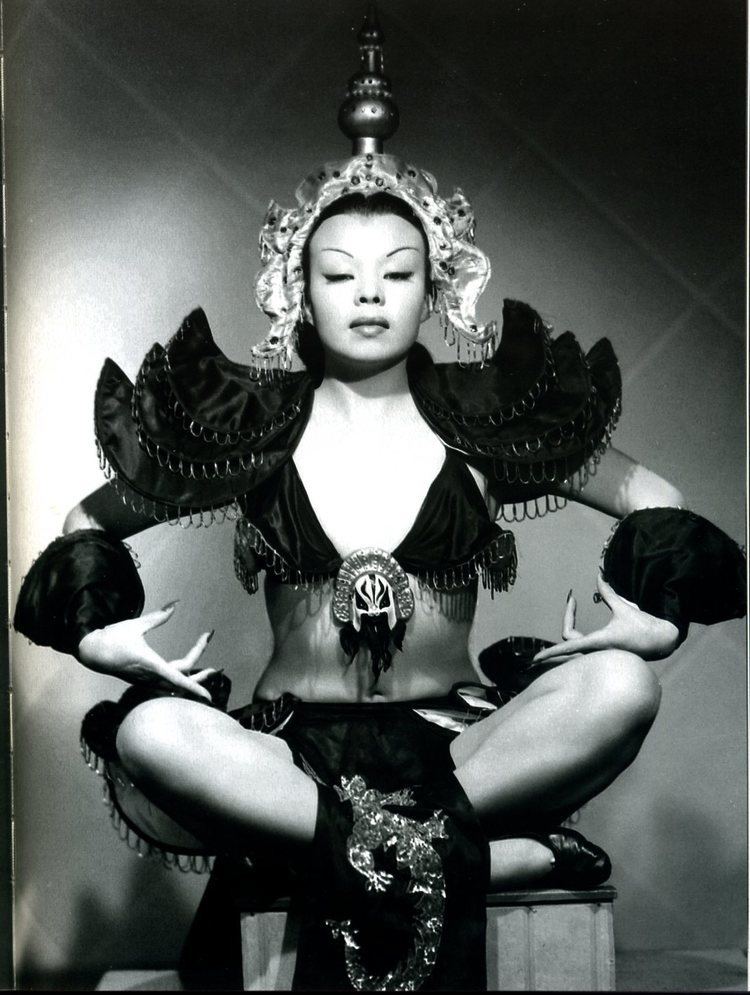Full Name Rosa Su Role Film actress Name Su Key | Years active 1948–1951 Occupation film actress, dancer | |
 | ||
Su Muy Key was a Mexican vedette, film actress and dancer of Chinese descent. She was one of the first Burlesque performers in México. She was nicknamed "Muñequita China" ("Chinese Doll").
Contents

Biography
She was sister of Margo Su, actress, businesswoman and owner of the famous Teatro Blanquita in Mexico City. She acted in some Mexican films like the La bandida (1948), Carta brava (1950), Mujeres de teatro (1951) and Especialista en señoras(1951). As a vedette and burlesque performer, she worked in numerous theaters and cabarets of the time. Her famous night show consisted of painting her body with silver paint and remaining immobile as a statue, and then dancing oriental dances.
In 1949 it was rumored that she would be the star of a film titled Poor butterfly, which never was concretized. Possibly in this year Armando Herrera, the "photographer of the stars" and who had become famous for portraying Agustín Lara and the young Tongolele, gave her an anthology portrait where she reveals her exquisite Chinese eroticism. At the beginning of 1951 she was portrayed naked by photographer Niuglo, a persistent contributor to Veja magazine. The caricaturist Segura added to a piquant photomontage that bordered on pornography.
Her sister, Margo Su, followed her footsteps in the movies, participating in numerous films and telenovelas.
Death
Her name occupied in 1951 great titleholders, because she was involved in a tragedy that cost her life and that of her lover, the businessman Roberto Serna. This fact has been one of the great unresolved enigmas in the world of entertainment in Mexico. The journalist Carlos Gómez M., related in this way the tragedy:
"Su Muy Key, Roberto Serna and Mrs. María López de Su, her mother, arrived at the Hotel Pal, Roberto's home. Roberto invited Su Muy Key to his apartment. She accepted and asked her mother to wait for her down saying: I'm going up with Roberto, we have an issue to solve, wait for me here, I will not be late.
The couple disappeared into the dark of the stairs. They were closely united in loving embrace. After a few minutes, three detonations disturbed the silence of the night and Su Muy Key's mother, hurried up the stairs. When she opened the apartment door, she found her daughter stretched out on the bed in agony in the middle of a puddle of blood. At her side, with the revolver still smoking in his right hand, Roberto Serna, lying on the bed and with a head wound. On a table in the room were some objects, including a letter in which Roberto ceded the entire ownership of the rights to the magazine "Oiga" to several people, including Su Muy Key."
Some people say that when they arrived at the Hotel, the couple found themselves in front of the businessman Felix Cervantes, who from a neighboring apartment had set out to observe the activities of the vedette. It is also said that between Serna, Su Muy Key and Cervantes a violent scene arose because the businessman seemed to go to fulfill his threats, that the tragedy happened after Cervantes and Serna, in the presence of Su Muy Key had put this one in the dilemma of deciding for either. Cervantes's absence in all investigations is based on the fact that, according to the same reports, the businessman returned to the neighboring apartment from where he had seen the arrival of the lovers and, realizing the magnitude of the tragedy, decided to remain hidden, to avoid complications.
The photographer Karol was the penultimate that captured her mysterious Muy Key's face. He noticed her worried and she told him that she no longer wanted to be exploited by her lover Roberto Serna, publisher of the magazine Oiga. Cervantes married later with Margo, sister of Su Muy Key.
Comments
Her sister, actress and businesswoman Margo Su, made a dislike of her sister in her book Alta Frivolidad (1990): "Rosa's skin is white and soft; With the lights of the theater she looks pearly. She's tall and with long arms, when she dances them moves sweetly and with elegance, gives the sensation of being in the sea. Her hair is black, crow-winged color with bluish flashes. She is beautiful. Even her name is cute: Su Muy Key. Muy Key means "Rose", in Chinese. The worst happened to her: she was labeled as a "Exótica" despite the fact that she is the opposite: Her dance is refined, ethereal, nothing ties her to the cry of African jungle or the sensuality of the Pacific islands. Su Muy Key is the mystical, elegant, mysterious and deep dance. She replaced Tongolele in the cabaret Club Verde with everything and the spectacular advertisements in the press and the huge posters stuck in all the streets of the city and, of course, her name was preceded by the fashionable adjective: The Exótica Su Muy Key. As sometimes happens, Rosa is totally different in her daily life to the figure of the scenes. She is simple and sweet in her dealings, an untiring accountant of jokes, she hates fame because she can no longer go to the market to choose her ingredients (she is a splendid cook) or stop talking to the butcher or the vegetable vendor. She goes out into the street without a drop of makeup on her face and dressed in simplicity, which seems wrapped in furs and silks. Either way, people are stunned in her wake, like an apparition. She has a lot of "angel" and a great personality".
In popular culture
Along with other contemporary vedettes (known in México as "Exóticas") like Kalantán, and Tongolele, Su Muy Key was mentioned in the Mexican novel The Battles of the Desert by José Emilio Pacheco.
